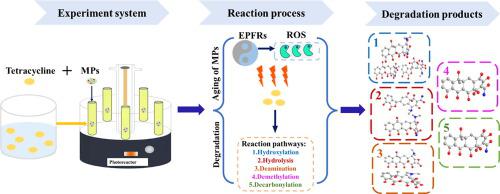Chemical Engineering Journal ( IF 13.3 ) Pub Date : 2022-01-21 , DOI: 10.1016/j.cej.2022.134827 Rui Ding 1 , Zhuozhi Ouyang 1, 2 , Linjie Bai 1 , Xin Zuo 1 , Chuanqi Xiao 1 , Xuetao Guo 1, 2

|
Tetracycline (TC) and polystyrene microplastics (PS MPs), co-occurring in environments inevitably, have been frequently detected in a variety of environmental media. The two major types of emerging pollutants are attracting the global concern due to their potential threat to biota. PS can serve as carriers of TC in aquatic environments, thus dramatically altering environmental behavior of individual PS or TC. However, the photolysis of TC induced by PS remains unknown. In this study, kinetic experiments, quenching experiments, electron paramagnetic resonance analysis (EPR), Two-dimensional correlation Fourier transform infrared spectroscopy (2D-FTIR-COS) and products identification, were conducted to investigate effect and underlying mechanism of PS on photolysis of TC under sunlight irradiation. The corresponding results demonstrated that PS could induce photolysis of TC. The hydroxyl radicals (·OH), singlet oxygen (1O2) and superoxide anion (O2·-) enhanced degradation of TC. Quantitative quenching analysis revealed that both 1O2 and O2·-were main contributors, with contributions of 15.25 ± 2.21% and 11.69 ± 1.84%, respectively. Simultaneously, PS was aged during photolysis of TC, and the intension of O/C was enhanced from 2.07% to 17.92% with increasing aging time. Interestingly, we verified that highly aged PS significantly accelerated the photolysis due to generation of environmentally persistent free radicals (EPFRs), and the degradation pathway of TC induced by PS was firstly proposed. Subsequently, the transformation mainly included five reactions: hydrolysis, hydroxylation, deamination, demethylation and decarbonylation. This work provided a promising strategy for better understanding environmental fate of antibiotics and MPs.
中文翻译:

聚苯乙烯微塑料诱导四环素光解的驱动因素是什么?
四环素 (TC) 和聚苯乙烯微塑料 (PS MPs) 不可避免地同时存在于环境中,在各种环境介质中经常被检测到。这两种主要类型的新兴污染物因其对生物群的潜在威胁而引起全球关注。PS 可以作为水生环境中 TC 的载体,从而显着改变个体 PS 或 TC 的环境行为。然而,PS诱导的TC光解仍然未知。本研究通过动力学实验、淬灭实验、电子顺磁共振分析(EPR)、二维相关傅里叶变换红外光谱(2D-FTIR-COS)和产物鉴定,研究PS对光解的影响及其潜在机制。阳光照射下的 TC。相应的结果表明PS可以诱导TC的光解。羟基自由基(·OH)、单线态氧(1 O 2 )和超氧阴离子(O 2 ·- )促进了TC的降解。定量淬灭分析表明1 O 2和 O 2 ·-是主要贡献者,贡献率分别为 15.25 ± 2.21% 和 11.69 ± 1.84%。同时,在TC光解过程中PS发生了老化,随着老化时间的增加,O/C的强度从2.07%提高到17.92%。有趣的是,我们验证了高老化PS由于产生环境持久性自由基(EPFRs)而显着加速了光解,并且首次提出了PS诱导的TC降解途径。随后,该转化主要包括五个反应:水解、羟基化、脱氨、去甲基和脱羰。这项工作为更好地了解抗生素和 MPs 的环境归宿提供了一种有前景的策略。











































 京公网安备 11010802027423号
京公网安备 11010802027423号